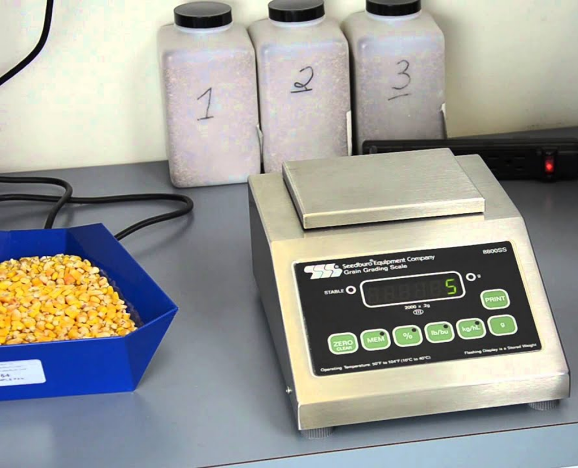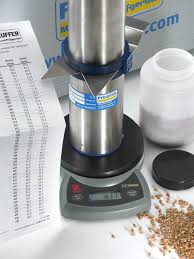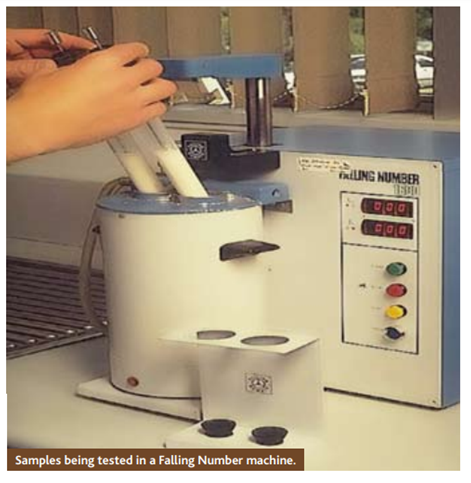The grading of grain is essential since prices for the product are determined by quality.
Grain grades are a tool used to define the quality of grain. Grades relate to a grain's end-use quality, meaning grades relate to how grain characteristics affect performance during processing (e.g. how much flour is produced during milling) or the quality of the end product (e.g. texture of cooked pasta).
The grading system provides a range of maximum permissible levels for a variety of important characteristics and so determines the various grades. This ensures that grain complies with certain functionalities, as well as safety and hygiene, and is free from disease, harmful seeds or other adverse factors within specific limits.
The grading system ensures that the quality of any product from any producer is assessed in the same manner. In addition, it is focused on the customer's end-use requirements for grain and is based on scientific support. The set of standards applied to grain to ensure that it meets a specific grade is based on the requirements for the final product. This means that the grading factors for grain will always be relevant to customers' needs. The grade requirements of grain and the corresponding maximum permissible levels were developed with the aim of making a positive impact on the end-use functionality. When customers buy grain according to the official grades, it is not necessary for them to rely on additional contract specifications. They can be assured of satisfactory performance of such grain.
All deliveries and shipments are accompanied by a document that assurance of grain quality to the producer or buyer. If there is a dispute regarding any aspect of the grain's grade or performance, the matter will be investigated immediately.
Benefits of Grading Grain
Apart from this, there are also other very important advantages inherent in a grading or standardization system, namely:
- It serves as an incentive to the producer to produce grain of good quality, as he is compensated in accordance with the standard quality of grain.
- It serves as a basis for the orderly marketing of grain.
- It promotes trade and financing because a specific class, subclass and grade are a guarantee of a specific quality.
- It assists prospective buyers in obtaining the specific standard or quality of product they desire.
- It lays down a standard which is understood by local- as well as international grain traders.
- It eliminates the necessity of contracts between buyer and seller.
- It eliminates the red tape and the time-wasting procedure of buying on sample.
- The grading regulations are, to some extent, based on the commercial requirements, to which grain must conform for a certain purpose.
- It simplifies the bulk handling, storage and management of the grain.
Grain Grading Regulations
The Department of Agriculture, Forestry and Fisheries ensures the ongoing development and maintenance of uniform standards for South African inspection and weighing procedures for grain.
Grading regulations promote fair business practices and a competitive marketing environment for grain and oilseeds. By the correct application of the grading regulations, fair and competitive trading practices are promoted to the overall benefit of consumers and the agricultural industry.
The grading regulations ensure reliable and accepted descriptions of crop quality and value, and promote economic health and prosperity in agriculture. The regulations contribute to the successful marketing of South African grain and related agricultural products through the creation of standards for quality requirements and provide guidelines for the regulation of impartial handling practices.
Grading regulations also provide quality control for the entire grain industry. These guidelines have been prepared under the authority of the Department of Agriculture, Forestry and Fisheries for the purpose of clarity and transparency in the grain industry. Grain grades are a measure of grain quality and therefore grain inspection and grading of grain consignments are of utmost importance. Scientific and technical programs and services support the determination of quality grain consignments. Grading regulations determine the definition of grading standards and ensure that these standards are applied consistently and provide consistent results for our clients on both the delivery and the customer side of a transaction. The regulations provide a breakdown of the official policies and procedures for the sampling methodology and the guidelines for a range of other requirements.
Sampling for inspection purposes must meet the requirements in the regulation for the particular crop. Subject to this regulation, the inspector will conduct an official investigation of the grain by taking a representative sample of the grain in the prescribed manner. The operator of a grain silo will install the necessary equipment for efficient and accurate weighing, sampling, inspection, grading, quality determinations, drying, cleaning and storage of all grain, grain products and screenings received or dispatched by the grain silo. The maintenance of such facilities, equipment and structure of the grain silo are prescribed in the regulations.
All grain accepted at commercial silo’s must comply with the highest quality. Strict grading standards and cleaning procedures at silos ensure that buyers get the quality they pay for. Cleaner grain will also lead to higher returns when processing.
Grain Grading Regulations per Commodity
The grading of grain, oilseeds and dry beans are regulated by the by the Agriculture Product Standard Act 1990 (Act 119 of 1990) and the Act on Foodstuff, Cosmetics and Disinfectants Act 1972 (Act 54 of 1972).
Notwithstanding the provisions of Sub Regulations, all consignments of grain, oilseeds and dry beans must meet the following minimum standard:
- Be free from any toxin, chemical or other substances that renders it unsuitable for human consumption or for processing into or utilization thereof as food or feed;
- May not exceed the permissible deviations regarding aflatoxin in terms of the Foodstuffs, Cosmetics and Disinfectants Act 1972 (Act No. 54 of 1972); 17 “aflatoxin” – maximum of 10 microgram aflatoxin per kilogram, of which aflatoxin B1 should not exceed 5 micrograms per kilogram;
- Poisonous seeds should not exceed the tolerance as prescribed in Regulation R1225 of 04/10/2002 of the Act on Foodstuffs, Cosmetics and Disinfectants 1972 (Act 54 of 1972);
- Ergot sclerotia - does not exceed the tolerance of 0.02% in a 5 kg sample of wheat;
- Be free from organisms of phytosanitary importance as determined in terms of the Agricultural Pest Act, 1983 (Act No. 36 of 1983);
- Be free from mould infected, sour and rancid other grain, foreign matter and any other matter;
- Be free from any sour, musty or any other undesired odour;
- Be free of animal matter;
- Be free from insects;
- Be free from stinking smut infection where applicable; and
- Have a moisture content not exceeding the prescribed limit for each grain, oilseeds and dry beans.
The grading of maize is stipulated in Government Gazette No R473 of 08/05/2009.
The grading of sorghum is stipulated in Government Gazette NO R 15 OF 08/01/2016.
The grading of wheat is stipulated in Government Gazette NO R 64 of 29/01/2016.
The grading of sunflower is stipulated in Government Gazette NO R45 of 22/01/2016.
The grading of soya beans is stipulated in Government Gazette NO R478 OF 20/06/2014.
The grading of dry beans is stipulated in Government Gazette NO R112 of 14/02/2014.
Grading Factors
Grades are assigned based on a sample’s ability to meet tolerances or specifications for various grading factors. A grading factor represents the physical condition of grain. The following factors are assessed when grading grains:
Moisture Content
This shows how dry the grains are. Moisture in grains affects grain storability as high moisture content may result in mould development, insect infestation and deterioration in quality. Therefore, grains must be dry when stored to prolong its shelf life.
Presence of Storage Insect Pests
Pests damage grains by reducing its physical and nutritional value. The presence of live insect pests in a sample results in rejection of the grain.
Presence of Poisonous Weed Seeds
Poisonous weed seeds such as Datura sp. render the grain unsuitable for human consumption; as such grain with poisonous weed seeds shall be rejected.
Foreign Matter
Any matter in grain such as twigs, soil, dead insects and seeds of a different crop constitute foreign matter. Stones, coal, metals, glass are not foreign matter as these materials are not allowed in grain and a sample containing such is regarded as reject grade.
Defective Grains
Defective grains are those that are insect damaged, immature and shrivelled, discoloured and broken.
Grains of Another Colour
This refers to grains of the same variety but with a different colour. An example when grading a sample of white maize, any yellow maize in that sample is referred to as grains of another colour. There is a specification for each crop for grains of another colour in a sample, above which the sample is rejected. Example: the acceptance level for grains of another colour for beans to be classified as Grade 1 is 10%.
Preparing for Grain Grading
Grading, as with many other factors in life, require some form of preparation before the activity can commence. Preparing the workplace prior to grading will include:
Wipe and clean the grading surfaces as grains, oilseeds, dry beans and other obstacles can contaminate the sample that will be graded.
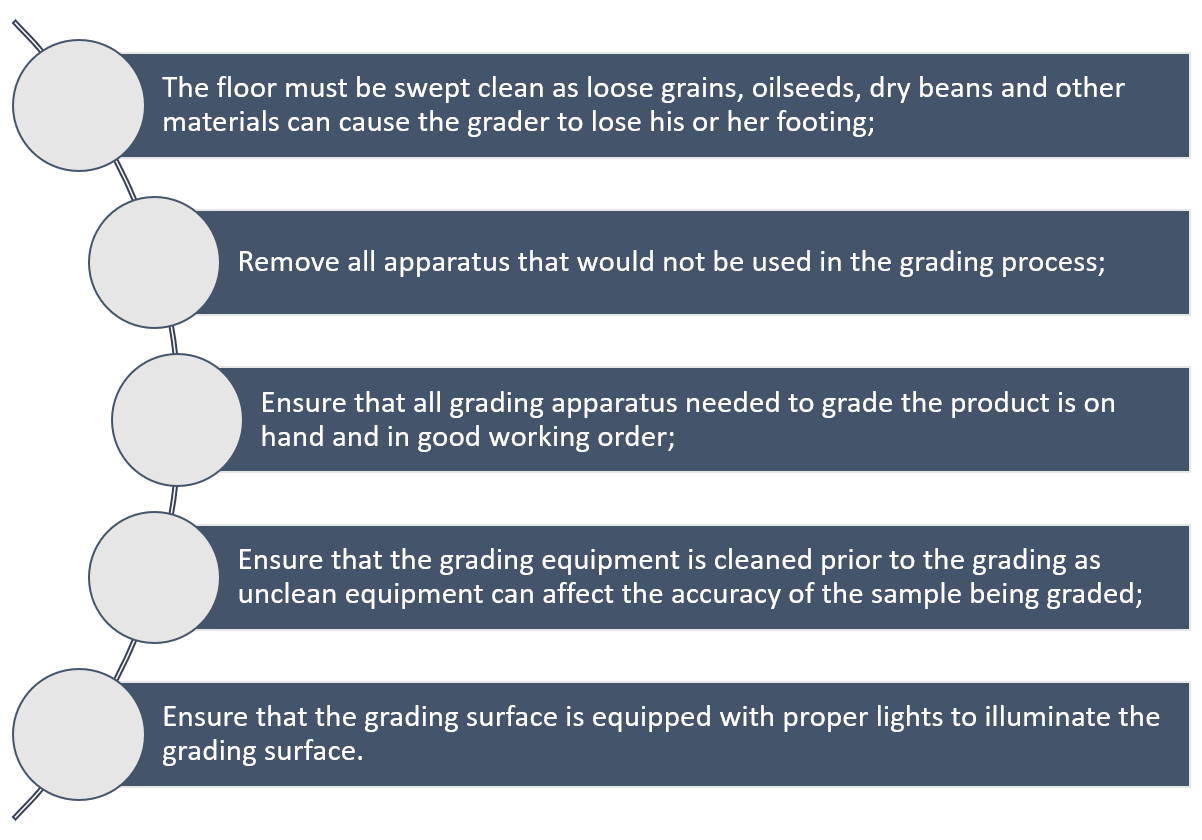
Preparing the workplace after the completion of the grading process:
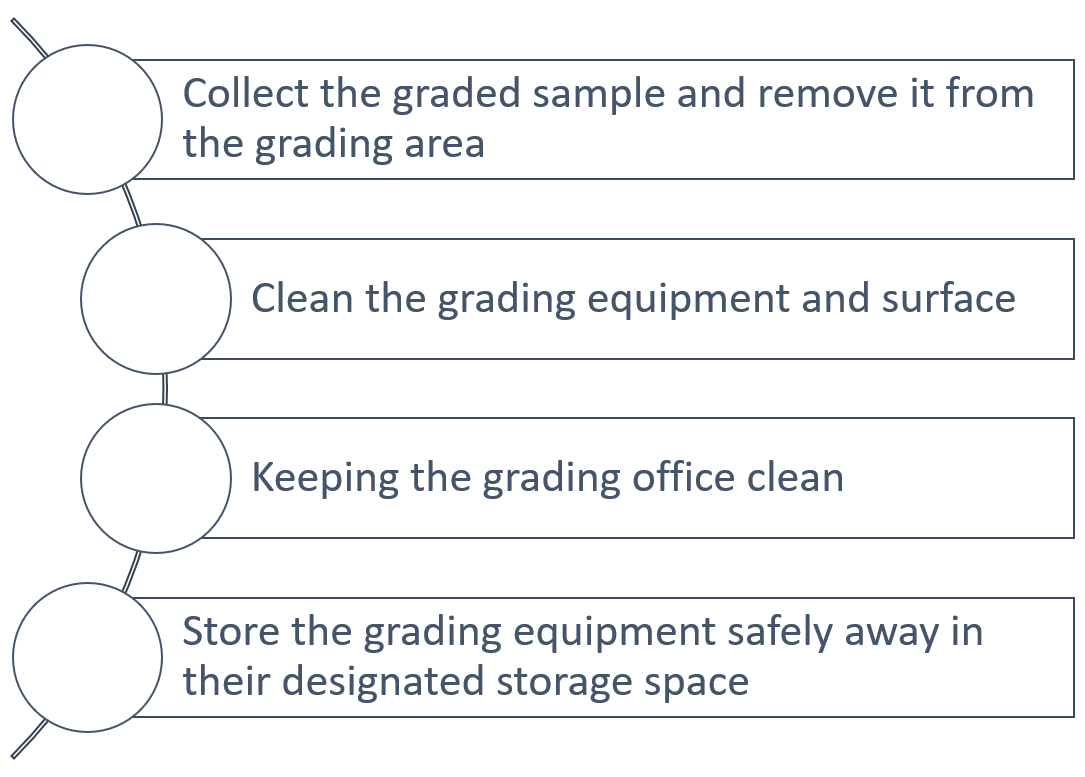
Grading is a process that takes place at a facility where the grader is subjected to potentially hazardous instances. From the first step of sampling up and to the disposal of the grading sample, the grader encounters situations that can cause bodily harm. The grader must allocate and use the appropriate personal protective equipment (PPE) when the grading is being executed as the use of safety equipment can prevent injury or death.
Grading Equipment
By law, all grading equipment must be calibrated. Legal actions can be instated against an organization for charges of fraud if the equipment utilized are not calibrated.
The following equipment is used in various grading procedures:
|
Scale
|
That which can determine the representative samples mass. The scale must be capable of determining mass of at least 15kg sample. A Grading scale is needed to determine the mass of at least 1kg sample with a one decimal accuracy (0.1g). When determining falling number, the scale must be capable of determining a samples mass with a two-decimal accuracy (0.01g). |
|
Moisture Meter
|
The moisture contents of a consignment of grain, oil seed or dry beans may be determined according to any suitable method, provided that the results thus obtained, are in accordance with the maximum permitted deviation for a class 1 moisture meter a method. The method referred to is the (AACC Method 44- 15A/1981). |
|
Protein Meter
|
The percentage of protein of a consignment of wheat may be determined according to any suitable method, provided that the results thus obtained are in accordance (± 0,3%) with the results obtained by the Dumas Combustion Analysis Method [AACC ("American Association of Cereal Chemists") Method 46-30]. |
|
Hectolitre Mass
|
The hectoliter mass of a consignment of wheat may be determined by any suitable instrument, provided that the instrument complies with the specifications detailed in ISO (International Organization for Standards) 7971-3. |
|
Falling Number
|
The Falling Number test has been in use in domestic and international wheat trading for over 40 years and has been adopted by key international organisations responsible for standardisation of methods. It is the internationally recognised method used by both traders and their customers who closely monitor wheat deliveries for sprout damage. International grain contracts commonly reference minimum falling number values. The falling/stirring number of a consignment of wheat may be determined according to any suitable method provided that: the results thus obtained are in accordance (± 5 present) with the results obtained by the ICC (International Association for Cereal Science and Technology) Standard No 107/1 method. Grading sieves: 6.35mm (± 0.05 mm) maize grading sieve 1.8mm wheat, sorghum and sunflower grading sieve 4.75mm (± 0.03 mm) soya bean grading sieve It is imperative that the sieve sizes are checked on a regular basis to ensure that the sieve complies with the prescribe regulations. |
| Multiple Slot Divider | The dividing apparatus must comply with the specified dimensions. |
All scales, moisture analyzers, and measuring equipment should be calibrated on a regular basis. The calibration should be verified with an appropriate calibration certificate. The intervals of the calibrations will depend on the frequency of use of the equipment or be done on an annual basis or when otherwise prescribed by the suppliers detailed in ISO 7700/2, based on the results obtained by means of the 72-hour 103° C oven dried.
Click here to view a video that explains grain test weight.
Click here to view a video that explains grain falling number.
Click here to view a video that explains grain moister testers, which meter is right for you.
